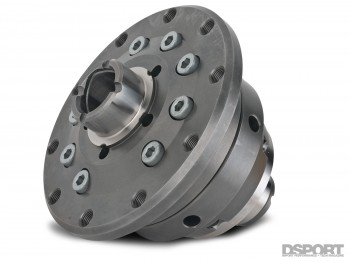GEARED UP
 Hundreds of thousands of miles can leave an engine under-powered but still going. However, it only takes a few grinds and mis-shifts to wreak havoc on a transmission. Used Honda transmissions are notorious for grinds, especially in third gear. For the 88-91 Civic/CR-X, a cable-type transmission is used from the factory and is simply the best way to go. Although some companies make an adapter kit to run a hydraulic transmission (from later models), a cable-type transmission such as the J1, S1, Y1, or YS1 is a bolt-in affair. Regardless of the transmission, it’s best to get the box opened up, inspected and rebuilt before swapping it in.
Hundreds of thousands of miles can leave an engine under-powered but still going. However, it only takes a few grinds and mis-shifts to wreak havoc on a transmission. Used Honda transmissions are notorious for grinds, especially in third gear. For the 88-91 Civic/CR-X, a cable-type transmission is used from the factory and is simply the best way to go. Although some companies make an adapter kit to run a hydraulic transmission (from later models), a cable-type transmission such as the J1, S1, Y1, or YS1 is a bolt-in affair. Regardless of the transmission, it’s best to get the box opened up, inspected and rebuilt before swapping it in.
 We took the YS1 over to Anaheim Gear in Anaheim, CA for a complete overhaul with new carbon-coated synchros, bearings, seals and two sliders that had endured severe abuse. With the transmission apart, we also had them swap out the factory open differential for a Quaife ATB limited-slip differential (p/n QDF1U). Simply put, an LSD outperforms an open differential in every single way. During straight line acceleration, an open differential only puts power to the wheel with less traction. An “ideal” LSD allows zero slip between the left and right drive wheels for maximum power transfer. When cornering, an open differential will tend to spin the inside tire (the tire that has less traction), causing sudden understeer. With an LSD, power is biased to the outside wheel to allow the driver to accelerate out of a turn much quicker. Whether it’s the strip, street or circuit, an LSD can greatly improve the handling characteristics of any vehicle.
We took the YS1 over to Anaheim Gear in Anaheim, CA for a complete overhaul with new carbon-coated synchros, bearings, seals and two sliders that had endured severe abuse. With the transmission apart, we also had them swap out the factory open differential for a Quaife ATB limited-slip differential (p/n QDF1U). Simply put, an LSD outperforms an open differential in every single way. During straight line acceleration, an open differential only puts power to the wheel with less traction. An “ideal” LSD allows zero slip between the left and right drive wheels for maximum power transfer. When cornering, an open differential will tend to spin the inside tire (the tire that has less traction), causing sudden understeer. With an LSD, power is biased to the outside wheel to allow the driver to accelerate out of a turn much quicker. Whether it’s the strip, street or circuit, an LSD can greatly improve the handling characteristics of any vehicle.
NEXT EPISODE
With the engine and transmission refreshed, the next step is to join them together and find a new home for the duo. Due to the popularity of the swap, many companies offer off-the-shelf parts that cater to a B-series powered 88-91 Civic/CRX. In the next installment of Swap Shop, we’ll cover all the swap specific parts you’ll need to get that B-series bolted up to your ride.


